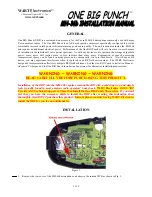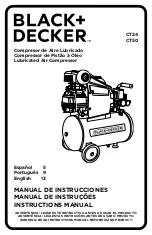
14
GENERAL MAINTENANCE (Cont'd.)
CENTRIFUGAL UNLOADER AND UNLOADER PRESSURE RELEASE VALVE:
The centrifugal
unloader is operated by two governor weights. It is totally enclosed and lubricated from the
crankcase of the compressor. When compressor starts, the governor weights automatically open
compressing the main spring, allowing the unloader pressure release valve to close. When the
compressor stops, the main spring returns the governor weights to normal position opening the
unloader pressure release valve and unloading the compressor. This prevents overloading the
motor when starting. If air continues to escape through the governor or unloader pressure release
valve while operating, this is an indication that the unloader pressure release valve is not closing
tightly and may be held open by foreign substance which has lodged on the seat. In order to
correct this, remove the governor release valve cap, giving access to unloader pressure release
valve spring and ball. Clean thoroughly and return parts in the same order in which they were
removed. Loose drive belts can also cause unloader to leak by preventing the compressor from
reaching proper speed. (See “BELTS” above.)
CHECK VALVE:
The check valve closes when the compressor stops operating, preventing air from
flowing out of the tank through the pressure release valve. After the compressor stops operating, if
air continues to escape through the release valve, it is an indication that the check valve is leaking.
This can be corrected by removing check valve and cleaning disc and seat. If check valve is worn
badly, replace same.
Before removing check valve be sure all air is drained out of tank and power is disconnected. Failure
to do so may result in injury or equipment damage.
THE INTERSTAGE PRESSURE RELIEF VALVE
is provided to protect against interstage over pressure
and is factory set for maximum pressure of 75 PSIG.
DO NOT RESET
If the pressure relief valve pops, it indicates trouble. Shut down the unit immediately and determine
and correct the malfunction. Inspect the head valves. Serious damage can result if not corrected
and can lead to complete destruction of the unit. Tampering with the interstage pressure relief
valve, or plugging the opening destroys the protection provided and voids all warranty.
COMPRESSOR LUBRICATION:
Fill crankcase to proper level as indicated by oil sight gauge. Keep
crankcase filled as required by usage. It is recommended that only Champlub recip lubricant be
used. This is a 30-weight, non-detergent industrial oil with rust and oxidation inhibitors specially
formulated for reciprocating compressors. Do not mix oil types, weights or brands.
MOTOR LUBRICATION:
Long time satisfactory operation of an electric motor depends in large measure
on proper lubrication of the bearings. Bearing grease will lose its lubricating ability overtime, not
suddenly. Refer to the motor manufacturer’s instructions for the type of grease and lubrication
intervals.
PILOT VALVE:
The pilot valve actuates the head unloader mechanism to provide a means of stopping
or starting the compression of air by the compressor without stopping or starting the electric motor.















































